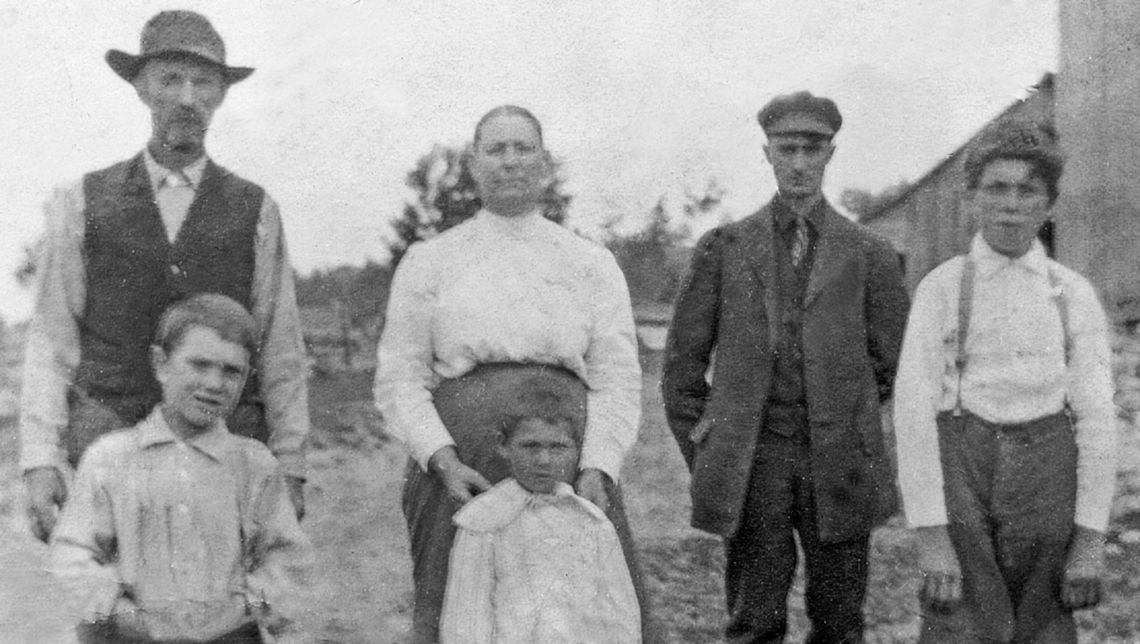This continues a series adapted from the book, “A Port Oneida Collection,” Volume 1 of the twopart set, “Oral History, Photographs, and Maps from the Sleeping Bear Region,” produced by Tom Van Zoeren in partnership with Preserve Historic Sleeping Bear. Here we have a look at the Brunson Farm, along the northern portion of Thoreson Road: Like many Port Oneida farms, the land that became the Brunson Farm was earlier owned and logged by timber baron Thomas P. Kelderhouse. It was subsequently inherited by his daughter Margaret, who married Joseph Brunson (or “Bronson”, as many documents say), also of the Port Oneida area. The Brunsons built a farm and raised five children. Leonard Thoreson remembered Margaret, who went by “Mag”: “You’d walk by here sometimes, you’d hear her singing & playing the organ. She wasn’t a good player, but she enjoyed it.” She played mostly hymns on her foot-pumped organ.
Two of the Brunsons’ five sons, Joe and Archie, stayed on here after growing up, and eventually took over the farm operation.
In contrast to their neighbors, the Thoresons and the Millers, the Brunsons never made it past a life of basic, hard-scrabble toil. Their rolling, lakeside land would be worth millions today—but as a farm the sandy hills offered little beyond basic subsistence. And unlike their neighbors, the Brunsons lacked the aptitude or enterprise to launch successful sidelines other than hiring out as manual labor at neighboring farms, or doing yard work for “resorters.”
“There were signs of hard life at the Brunsons’ house,” recalled next-door neighbors, the Watkins sisters. “I think these people really had to scratch.” The house was “very modest — unpainted — dark and low — kind of into the bank.”
Despite their hardships, the Brunsons are remembered as friendly, if “reserved.”
“They seemed to get along with everyone.” Bob Adair, grandson of neighbor Ellen Miller, laughed as he remembered Archie: “You could hardly understand what he was saying, because he had about two teeth in his mouth; but he had a heart of gold — but he would swear at those horses like a stevedore, trying to get them to do what he wanted them to do.”
Laura Basch remembered that Joe (junior) had a “live-in friend” named Doris, whom he called “Dort.” When Joe eventually left to work on the lakers (Great Lakes ships), Doris just stayed on with Archie. The Watkins sisters (Ch. 30) remember, “She always wore this Mother Hubbard dress, and her hair was cut in bangs and short and gray. It seemed like she always came out on the porch to wave when you drove by.”
The Brunsons’ small house was “pretty much one big living room,” which also served for meals. On the west side was a small parlor with the old organ. The main bedroom occupied the other side. There were two bedrooms upstairs, and a woodshed in back.
As a boy, Leonard sometimes helped his neighbors with potato planting or other jobs. He remembered the free-standing motor the Brunsons picked up somewhere to pump water, power the buzz rig for cutting firewood, and other tasks—“the biggest one-lunger (one-cylinder) motor that I’ve ever seen. It had flywheels that set up about that high (chest high.) Oh, it was a big brute — and why they bought it, I don’t know.” Although it was mounted on skids, “It was so big they couldn’t use it for anything. They had woods up there off the Wheeler Road, and a team of horses couldn’t drag it up there to put it on the buzz rig. It was so big they couldn’t haul it around.”
The motor was usually attached to a pump by the well, with a pipe that ran under the road to the house. There the Brunsons had a tank under the back shed with a hand-pump on it. They also had a tank in the barn they could pump water to. They dipped water for the cattle from that tank with a bucket. ~~~ Joe (senior, the father seen in the photo) had a brother Charlie who, with his wife Anastasia, purchased the old Pete Burfiend Farm along Basch Road (which some will remember as the Milton & Mildred Basch Farm), and raised their family there.
Their brother Frank moved to Empire, where he and his wife Maude raised seven children, beginning when Maude was sixteen. Census records show Frank to have been a “lumber woods laborer”.








